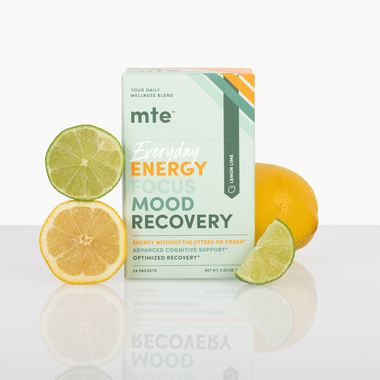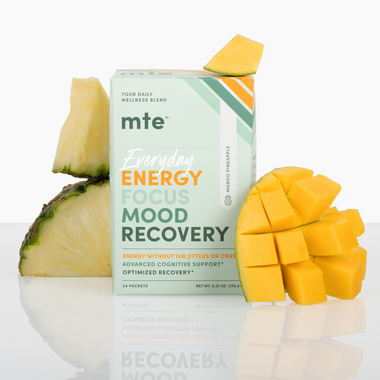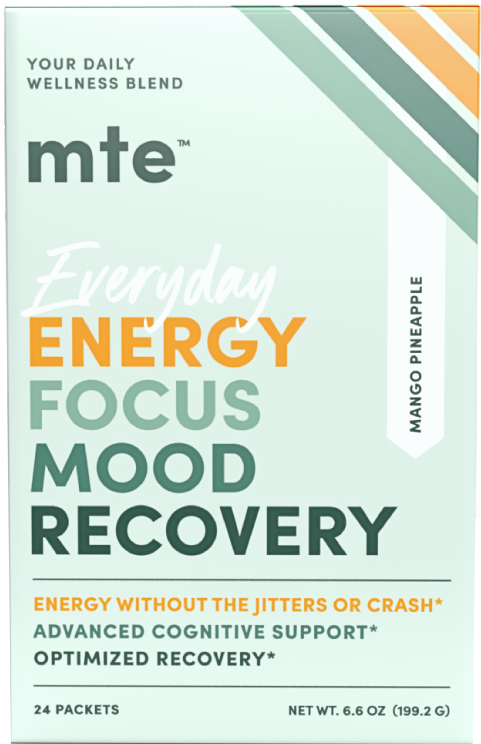
Uncovering the Secrets of Eleuthero: Origins, History & Use
One of the 10 adaptogens, nootropics and superfoods in MTE’s daily wellness and energy powder is eleuthero (Eleutherococcus senticosus), also known as Siberian ginseng. A relatively new player in Western medicine, this rough, woody shrub has roots that look and interact with the body like Asian ginseng (Panax ginseng) but are decidedly not.
Modern uses for eleuthero drinks and supplements remain somewhat experimental as clinical research endeavors to validate medical uses of this little-known adaptogen. However, like most medicinal plants, there is ample evidence for ancient and historic uses of eleuthero tonics in traditional medicine, in this case especially in Russia and China.
Northeast Asia & the Ginseng Impersonators
Botanically speaking, true ginseng is in the Panax family; a group of shrubs with tuberous roots, many of which offer various benefits to humans for use in food, drink, powder, or other forms. The ginseng plant traces its name back to the Chinese words for “person” and “root,” for the somewhat-creepy, somewhat-cute shape and legs of the root of the shrub. However, when we hear people talking about ginseng health supplements and ginseng immunity tonics, they’re often referring to pseudo-ginsengs
Central and East Asia are home to Asian ginseng (the OG) as well as a couple non-panax relatives: Indian ginseng and Siberian ginseng. Indian ginseng’s scientific name is Withania somnifera, and if that sounds familiar, it’s because another name for Indian ginseng is ashwagandha! Botanically, ashwagandha is unrelated to ginseng and interacts with the body as an adaptogen in different ways.
(Learn more about Ashwagandha’s adaptogenic qualities and how it promotes wellness and vitality.)
Eleuthero is a little different. While the medicinal properties of true ginsengs comes from their ginsenoside content, eleuthero's adaptogenic properties are believed to come from its eleutherosides. Eleuthero looks and acts like real ginsengs but may offer a wider range of benefits we’ll discuss later on.
Often, adaptogens that offer similar benefits are grouped into a short hand, which is why we refer to this eleutherian as a “ginseng.” True ginseng, though, is always identified by its ginsenosides and gintonin. Interestingly, while we have ideas about how eleutherosides affect various bodily processes, the most common answer is “unknown mechanism,” which is basically the medical term for ¯\_(ツ)_/¯.
Historical Uses of Eleuthero & Ginseng
The exact origins of eleuthero are unclear. It’s theorized that Asian ginseng has been used medicinally for 5000 years. However, the first evidence identifying Asian ginseng as a medicinal herb is from a Tang Dynasty medical text that dates back over 2600 years. Following that is evidence of cultivation in Korea c. 200 BCE, and mention of ginseng as a medicinal herb in a Chinese medical text from c. 200 CE.
By the 11th to 12th centuries, Asian ginseng was sold all across Europe and Asia, including the Arabic Peninsula, with Japan and China as its largest producers. It was easy to cultivate in many different localities because it’s such a hardy little shrub. Meanwhile, in North America, where another true ginseng grows naturally, records from early 18th century European invaders record various Indigenous groups using ginseng in paste and tonic forms for generations before their first encounters.
Why are we talking about the history of actual ginsengs? Simply because there is little way to tell which ginsengs anyone is talking about in early texts. Each of the 4 “ginsengs” - Asian, American, Indian, and Siberian – have over a dozen colloquial names. In addition, other members of the eleuthero family historically were used alongside true ginsengs, so there’s also that. Linguistically and culturally, there’s a lot to unpack there, but suffice to say, we have little idea exactly when eleuthero came on the scene as an adaptogen.
The first textual evidence referring specifically to the use of eleuthero as an immunity herb doesn’t come until 11th century China. Was it cultivated, traded, and used the way Asian ginseng was for all these centuries and we just forgot until we really needed it again? Or does its history really just begin in the 20th century when we started to panic about over-harvesting Asian and American ginsengs?
Because humans are wont to overconsume things until they’re dead and ruined, there’s a ginseng shortage, and it began nearly a century ago. Cultivators in Northeast Asia and North America couldn’t keep up with demand, so Asian ginseng and its American cousin had been harvested to the point of endangerment.
Russia was one of the first to see a ginseng shortage coming, so began searching for a substitute for true ginseng in the early 20th century, when they stumbled upon eleuthero. Fast forward to today and ginseng is so far gone that we’re literally having cross-continental conferences on how to revive the American species of panax ginseng by growing it in other places.
As well, the Appalachian region of the US, where American ginseng thrives, is taking measures to regulate the international trade of the roots and revive the wild plant at home to protect the plant from further endangerment.
Does Eleuthero have the Same Medicinal Qualities as True Ginseng?
Traditional uses of true ginsengs range from heart health to immunity to cognitive function and ED. Like its much more established adaptogen friend, ashwagandha, there’s got to be a reason or five that ginseng has been cultivated and sought after for so long. Unfortunately, the waning population of true ginsengs have made it less available and often prohibitively expensive.
So, can eleuthero save the day? And what is it that makes a Siberian ginseng energy drink rise to the level of functional? Anecdotal evidence from the last thousand+ years abounds with regard to what eleuthero is good for. But since it’s only got about 80 years of clinical research under its belt since Russia began studying it in the ‘40s, it can be hard to suss out what’s fact about this feel-good herb and what’s fiction.
Thankfully, the World Health Organization is here to help. In 2002, WHO published a statement in support of the clinical evidence for eleuthero supplements: “As a prophylactic and restorative tonic for enhancement of mental and physical capacities in cases of weakness, exhaustion and tiredness, and during convalescence.”
In 2014, the European Medical Agency (EMA) approved eleuthero for symptoms of asthenia, including fatigue and weakness. In 2025 alone, two separate meta-reviews of the literature on eleuthero were published – so the adaptogen’s clearly got a lot going for it.
What is Eleuthero Typically Used For?
Used for centuries in traditional Russian and Chinese medicine, proponents of this not-actually-a-ginseng adaptogen utilize it for several purposes:
- Treat viral infections like the cold and flu
- Lessen fatigue and improve cognitive performance
- Reduce pain symptoms of osteoarthritis
- Treat chronic bronchitis
- Cholesterol control
- Blood pressure support
- Treat sleep problems
It appears as though eleuthero interacts with our system as an anti-inflammatory that provides support for your cardiovascular and immune system, and it may also act as a nerve protectant. Already, herbal Western medicine is getting on board with the potential of eleuthero for treating everything from chemo side effects to heart failure. But centuries of cultivation, experimentation and experience say that there’s a pretty good chance this two-legged root may offer support for overall daily wellness and longevity.
Clinical Evidence for Eleuthero as an Effective Adaptogen
The World Health Organization goes into great detail on the body of significant studies on eleuthero so far, including experimental pharmacology, which suggests that it not only has anti-stress properties, but antimicrobial aspects as well, and may help regulate hormones. This is inferred from a collection of rat studies that showed an ethanol extract of eleuthero:
- Improved rats’ resistance to noxious chemicals.
- Decreased the effects of stress response hormones on the thymus and spleen.
- Suppressed stress-induced gastric ulcer formation.
- Increased sleep duration and quality.
- Increased resistance to introduced infections.
- Inhibit ADP-induced platelet aggregation.
Super cool, right? Not for the rats, but here we are.
Clinical data presents just as interesting indications for eleuthero's adaptogenic anti-stress potential (summarized in the meta-reviews linked above):
A meta-analysis of clinical studies from Russia spanning the 1960s-1970s, in 2100 healthy people, a daily tonic of eleuthero for 60 days significantly improved cognitive and athletic performance under stressful conditions, decreased incidence of sickness and reduced symptoms of auditory deficits.
A body of 35 studies on 2200 people with varying chronic conditions like high blood pressure, diabetes and heart problems, a 1-3x daily dose of eleuthero for up to 8 rounds of 35 days each, overall results were positive – blood pressure levels were regulated, cholesterol levels reduced, an subjects reported better performance at work and quality of life.
A placebo-controlled clinical trial used baseball players to explore maximum work levels and time, including HR and VO2. The 6 subjects were administered a course of 2ml eleuthero drinks daily, after which work time and exhaustion time were measured. While the placebo group saw a 7.5% increase in work time, the group who had been taking the eleuthero saw an over 23% increase.
In a randomized, placebo-controlled clinical study exploring the immune-boosting properties of eleuthero, 36 healthy adults consumed a 10ml dose of the adaptogen 3x daily for 4 weeks. The eleuthero group saw a significant increase in immunocompetent cells, including T-cell activation.
In a comparative study on blood coagulation caused by high-intensity activity in elite athletes, those who took a course of eleuthero showed significantly lower levels of activity-induced blood coagulation.
Contraindications for Eleuthero as a Medicinal Root
It’s not all good news, obviously; not every clinical trial reaps the results the researchers are hoping for. For instance:
In a randomized placebo study on eleuthero consumption’s effect on athletic performance, long distance runners were given eleuthero daily for a course of 8 weeks. In all measures, including O2 consumption, HR and perceived fatigue, no significant differences were observed after the 8 weeks.
In a crossover study comparing eleuthero, ginseng and placebo effect on maximum oxygen consumption, only those who took the course of ginseng saw significant improvements in any of the measured parameters.
There are also some people who eleuthero tonics might just not be right for. Current data suggest avoiding this specific adaptogen if you are pregnant, lactating, or take digoxin for migraines.
Fun fact: digoxin relies on another medicinal herb, fox glove, which does not play well with other plants and has also ruined some people's color vision.
But as for eleuthero, just listen to your body; occasionally, people have had adverse effects like sleeplessness, distress and hypertension.
Cultural Relativity & Medicine: Folk vs Clinical
Just kidding; we’re not going to get into that philosophical argument. Can you imagine? However, there is a salient point of the question of the validity of different medical traditions that is important here:
Just because our pharmacology is based in bioactive medications and medical procedures backed by clinical research, that in no way means that pharmacologies based in herbal remedies like analgesic pastes and resistance tonics backed by millennia of use are any less valid or valuable. Western medicine is beginning to come to this understanding, which is a part of why medical research is now trying to clinically validate what folk medicine already knows.
The vast majority of people who use, and have used, eleuthero over the last 2000 years will tell you its inclusion in any daily wellness drink has the potential to improve resilience and quality of life. And while anecdotal evidence is… anecdotal… that doesn’t mean it’s to be written off. After all, if eleuthero hadn’t had such good word of mouth, we may not have started clinical studies at all. And then once the real ginsengs finally kicked the bucket, where would we be?
Integrating Past Knowledge with Present Technology
Your best options for incorporating this powerful adaptogen into your life is through a wellness powder or a liposomal tincture. These sorts of products offer concentrated, high-fidelity doses of the extract. It’s a key companion in any holistic energy drink – not only does it revitalize, it also balances, and that’s the key to really restoring your ability to feel good, sleep well, and be healthy.
Consider a daily supplement of pro-focus, mood-supporting adaptogens, nootropics, and superfoods - a natural, feel-good drink that uses eleuthero, the ashwagandha we mentioned earlier, and more, to promote immunity, stress resilience, sustained energy, and recovery at night. Caffeine-free of course, and no artificial sugars, either. Curious? Check this out.






